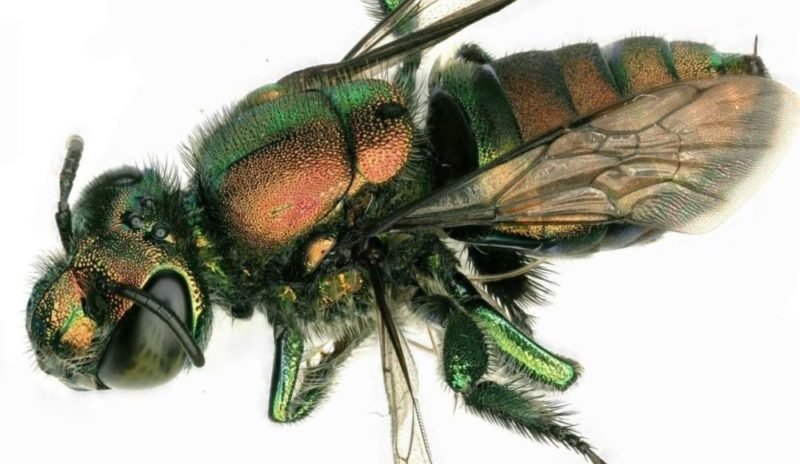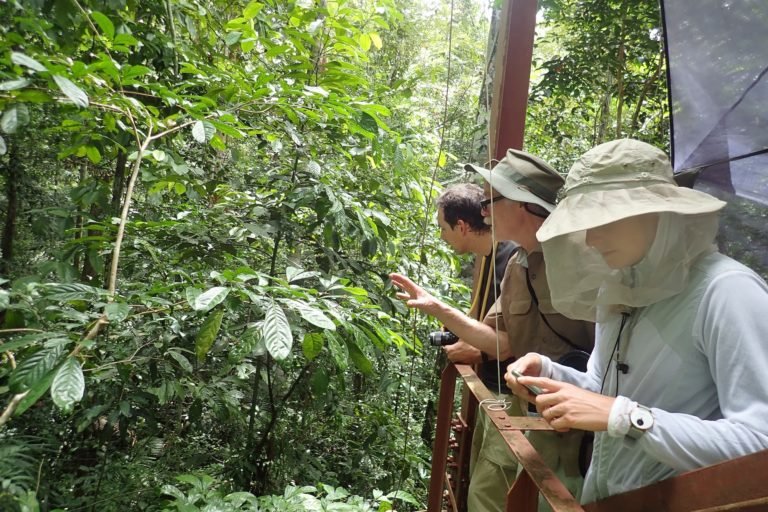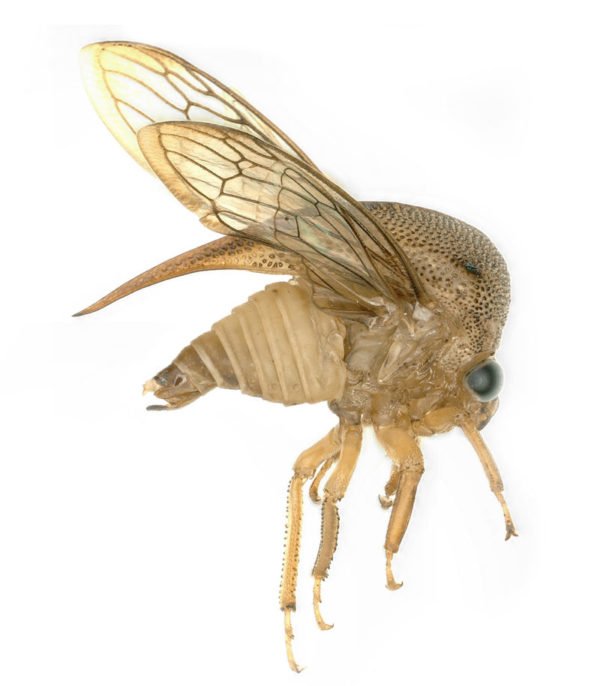- A new study collected tens of thousands of insects from the rainforest canopy in the Brazilian Amazon and found that 60% of the specimens occur at a height of 8 meters (26 feet) and higher.
- Most of the species, and even entire genera, have not yet been described by science, pointing to an unfathomable richness in insect diversity in the Amazon.
- This survey differs from conventional research on insects, which are usually conducted at ground level, because it pays more attention to the vertical diversity of the forest, from the ground to the treetops.
Small and often imperceptible to the human eye, insects play a vital role in the environment.
“They appeared more than 400 million years before humans,” says Dalton de Souza Amorim, a researcher from the University of São Paulo. “They took part in the evolution of natural environments and are vital in the processes of recycling and maintaining ecosystems by controlling populations of other animals and plants, pollinating, and serving as food for other species. Without insects, there would be no life in terrestrial environments as we know it today. And without them, there will be no natural environments either.”
That’s why entomology, the study of insects, has long been an important field in biology. But for obvious reasons, field research on insects is most often conducted close to the ground or at low altitudes. But a study carried out at 32 meters high, or 105 feet, in the treetops in the middle of the Amazon Rainforest, resulted in an amazing finding: about 60% of the insect density in the region is found in the canopy, at 8 m (26 ft) and higher. What’s more, most species and even entire genera have not yet even been described by science.
These findings came from a joint effort by researchers from several Brazilian institutions and the Natural History Museum of Los Angeles County, recently published in a study in the journal Scientific Reports. Their study began in 2017, installing “flight interception traps” to collect insects at the National Institute for Amazonian Research’s (INPA) Tropical Forestry Experimental Station. The station features a metal tower more than 50 m (164 ft) high, installed in an area of primary forest that’s preserved for scientific studies, about 40 kilometers (25 miles) north of the city of Manaus in Amazonas state.
The researchers set up five large nets on the same vertical axis, taking advantage of the tower’s platforms, starting at ground level and then every 8 m up from there, with the last one located 32 m above the ground, clearing the top of the tree canopy by 4 m (13 ft).
“The insects that fell into the traps were stored in containers with alcohol to preserve them,” says José Albertino Rafael, a researcher at INPA. “This material would be removed every 15 days, and each stratum would be properly identified.”
They collected nearly 38,000 insect specimens in the first sample alone, and repeated the experiment over the next 13 months. In a laboratory, they used microscopes to identify and sort the insects according to their orders. The most abundant ones were Diptera, the group that contains flies and mosquitoes, of which the researchers found nearly 17,000 individuals. They then sent out the insects to 35 experts in Brazil and abroad to help identify each species.
“We were surprised, because our method warned us to the fact that traditional studies usually carried at ground level still underestimate the real richness of our forests,” says Rafael, senior author of the new study.

Diversity in the heights
Since the early 20th century, scientists have known treetops are home to a highly diverse array fauna. But information about it was highly fragmented. In the 1980s, some studies began to show more systematically that unknown and rare insect species live in the canopy. Forty years ago, at the beginning of his scientific career, Rafael was already experimenting with suspended nets in the Amazon, but he knew that larger and more efficient traps were needed.
Today, about to retire, he celebrates the result of his work in partnership with a large team of fellow entomologists. But he points out that much has yet to be discovered. “Our insect diversity is not well known, given the immense unexplored richness living in the canopy,” Rafael says.
“Our study showed that not only is the number of species huge: the complexity of the environment is incredibly high,” adds Amorim, the lead author.
He cites the predatory insects that they found, with different numbers in each 8-m band. There were also parasitical insects, much more abundant above the canopy than at ground level, as well as species whose larvae eat fungi; more than 30% of these specimens were collected in the canopy, where, interestingly, there are no fungi.

Amorim says species in each of these groups are distinctly distributed throughout the various levels of the forest.
For some groups, the patterns are very distinct. About 70% of the species in the fly family Lauxaniidae were only found above ground level. Another fly family, the Phoridae, presented a huge surprise to co-author Brian Brown, curator of entomology at the Natural History Museum of Los Angeles County.
“Considering their appearance, specimens collected in the tower do not seem to belong to any of the genera already described [by science],” he says.

Conservation depends on knowledge
Their study includes only the analysis of material collected in the first two weeks of the 13-month project. This means a huge amount of samples and data have yet to be assessed.
“This stage took six months, just to separate Diptera orders and families, and then almost two years for the experts to analyze each family, with an additional year to wrap it up and prepare the article,” Amorim says. “It’s lengthy work to create new knowledge about biodiversity, with massive studies.”
He says the results of the study conducted high up in the Amazonian treetops should serve as a basis for studying insect life in forests around the world.
“As there is little research on the vertical diversity of insect fauna, we still have a lot to learn,” he says.

The next stage of the project could involve more than 400 researchers from Brazil and abroad, in three different locations in the Amazon. The idea is to understand how many insect species, and the percentage of species from various orders, live in a single rainforest area.
With an increasing global focus on biodiversity conservation, there’s much that still remains unknown about the richness of the species that live in a forest such as the Amazon.
“The findings in this study are important because they focus on the complex mosaic of insects that live in the rainforest and how much of it is still unknown,” Brown says. “Our analyses will lead to further work to investigate how stable these different insect communities in the canopy are, how they interact, and how they respond to human disturbances. By increasing our knowledge, we might be able to mitigate some of the worst effects of deforestation, but at least we showed that there is more at stake than we used to think.”
And only when we learn exactly who they are, how they act and how the inhabitants of the forest interact — from insects to large mammals, as well as vegetation itself — will we be able to devise effective conservation strategies, the thinking goes.
“Considering that the results are restricted to a point in the Amazon, when we extrapolate them to the entire biome, the huge number of species to be described becomes evident,” Rafael says. “We still don’t know all the organisms that live with us in nature, but we spend billions to discover species in other planets. What’s more important to man?”
Citation:
De Souza Amorim, D., Brown, B. V., Boscolo, D., Ale-Rocha, R., Alvarez-Garcia, D. M., Balbi, M. I., … Rafael, J. A. (2022). Vertical stratification of insect abundance and species richness in an Amazonian tropical forest. Scientific Reports, 12(1), 1734. doi:10.1038/s41598-022-05677-y
Banner image: An insect from the Carabidae family, known as the terrestrial beetle. In the rainforest, many of them patrol the top of the canopy, high above the ground, in search of prey. This one was captured at a height of 24 meters (79 feet). Image by Brian Brown/Natural History Museum of Los Angeles County.
This story was reported by Mongabay’s Brazil team and first published here on our Brazil site on March 22, 2022.











